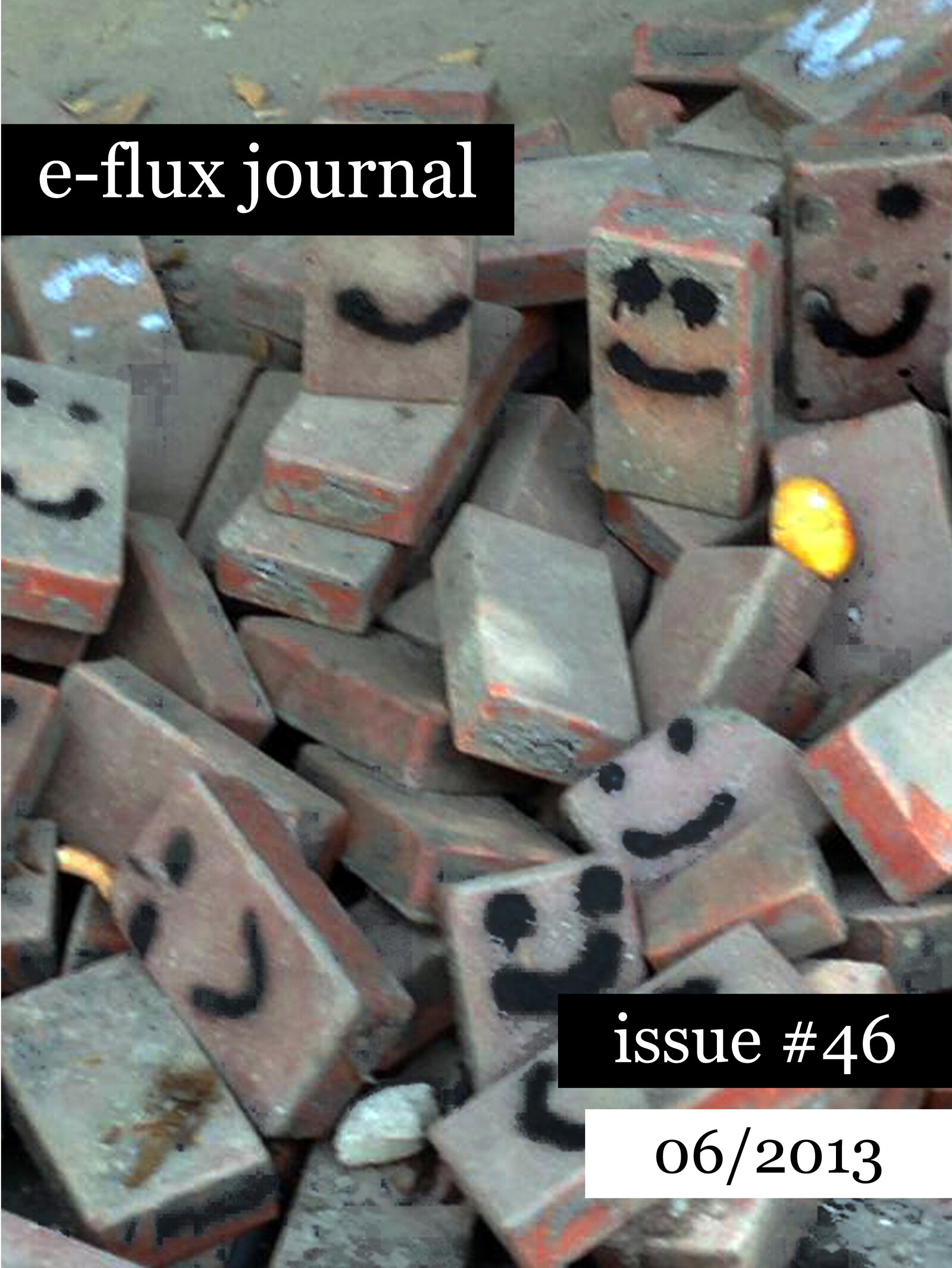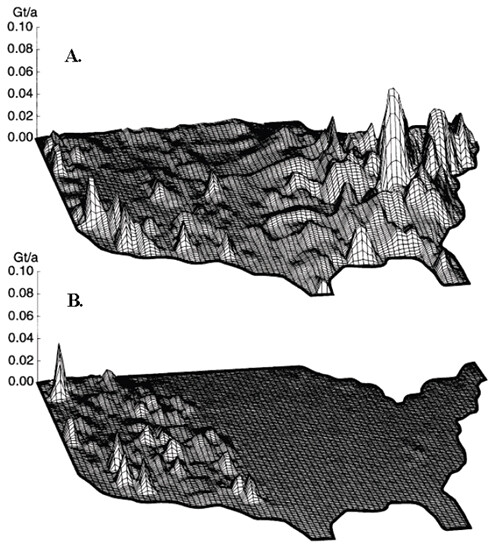Categories
Subjects
Artists, Authors, and Curators
Types
Years
Sort by:
Filter
Done
10 documents
Editorial—“As the world falls apart…”
Julieta Aranda, Brian Kuan Wood, Gean Moreno, Stephen Squibb, and Anton Vidokle
So this is the plan that we came up with in the huddle, stunned and not so stunned at the storm clouds that have broken, at the deluge that is here: we are putting up alternative facts to the alternative facts that are being deployed in a rightward swerve that has us up against the rails. We are also putting up an alternative common sense to the centrist liberal one that is what ultimately, at the fundamental level, keeps this world from coming undone, preservation being its constitutive…
e-flux Journal
Posted: February 2, 2017
Subjects
Editorial
La Ville Souvenir
Ernesto Oroza and Gean Moreno
What would happen if every souvenir shop and stand was invaded by an abstract souvenir, something that everyone, even children, recognize as a malefic mass? And what if this mass all of a sudden was to be acknowledged by a baffled population as a proper sign to identify the city by? What if, magically eliciting little hostility, the souvenir was simply accepted and reproduced, despite the diffuse disgust and pointed fear that it generated in everyone? Imagine hundreds of thousands of malefic…
e-flux Journal
Posted: May 1, 2015
Subjects
Commodification
“Un solo palo no hace monte”: Notes on the Otherwise’s Inevitable Infecundity
Gean Moreno and Ernesto Oroza
Once Upon a Time
Hamlet is seated on a throne. He’s bent and wasted. An imperfect Hamlet, frozen in place; history stretches between him and us like an unbreachable wall. His left hand holds up a fallen brow. All is dark around him. Foreboding. Tenebrous. The only light on the set is absorbed by the deep furrows on the prince’s hands. This is the wrong way for a film to start. 1 From the very beginning, it forces us to retune our understanding of the subject, to perk up in…
e-flux Journal
Posted: October 1, 2014
Category
Film, Capitalism
New Ancestors: A Conversation with McKenzie Wark
Gean Moreno
Gean Moreno: Survivors of the strange hallucination that was called the End of History, we seem to be speaking again, and brazenly, of the Outside—an outside to the existing socioeconomic arrangement, an outside to existing forms of everyday life, an outside to the authority of institutionalized discourse. It is in relation to the reassertion of this figure or trope of the Outside that I read your contribution to Excommunication: Three Inquiries in Media and Mediation , and in particular…
e-flux Journal
Posted: January 1, 2014
Category
Interviews & Conversations, Philosophy, Contemporary Art
Subjects
Media theory , Science
Editorial—“Accelerationist Aesthetics”
Gean Moreno
Where did the critical tradition of art go? Maybe that’s the wrong question. Because we know the answer. It went into spectacle. It went into finance. It got privatized, democratized, scrutinized, defunded, bureaucratized, then professionalized. The critical stick became a seductive carrot. But maybe we don’t have to see this only in terms of a fall from grace. Maybe this is the time for a long-overdue realism that an art field still in the thrall of modernist humanism struggles to avoid…
e-flux Journal
Posted: June 1, 2013
Subjects
Editorial
Notes on the Inorganic, Part II: Terminal Velocity
Gean Moreno
→ Continued from “Notes on the Inorganic, Part I: Accelerations”
Three pages from the end of his Post-Cinematic Affect , a book that treats recent audiovisual productions as mappings of the spaces and affective modulations of neoliberal capitalism, Steven Shaviro finally names what he has been making a case for throughout the book: “accelerationist aesthetics.” 1 Coined by Benjamin Noys, “accelerationism” is the name that has been given to a political tactics that comes down from…
e-flux Journal
Posted: February 1, 2012
Category
Capitalism, Technology, Film
Subjects
Apocalypse , Climate change, Accelerationism, Sublime
Notes on the Inorganic, Part I: Accelerations
Gean Moreno
For capitalism to sustain itself, to reproduce indefinitely, it needs to incrementally gobble up more and more. It must continually overturn any balanced cycles, as they can lead to stagnation and lost opportunities for growth. Extinctions are drawn to it like filaments to a magnet. The imperative to grow and the need for unrestricted license to devastate are two sides of the same coin—not only mutually dependent but structurally essential. Yet, however deplorable, growth and devastation can…
e-flux Journal
Posted: January 1, 2012
Category
Capitalism, Technology
Subjects
Apocalypse , Climate change, Accelerationism
Generic Objects
Gean Moreno and Ernesto Oroza
1.
By generic objects we don’t mean objects that affect a kind of generic quality—brilliantly commonsensical and ordinary objects that come from the rarefied space of the designer’s studio, and draw their value from that space. We mean really generic—milk crates, plastic buckets, shipping containers, wooden palettes, traffic barricades, decorative concrete blocks, urban trash cans and dumpsters, rubber tires, scaffolding, Scotch tape. It’s not that any of these aren’t designed,…
e-flux Journal
Posted: September 1, 2010
Category
Design, Aesthetics
Farewell to Function: Tactical Interiors
Gean Moreno
Disorientation: We Are Almost There
Many of the more prominent artworks produced in the last decade or so are characterized by a recasting of what were once called installations as something closer to interiors, relegating the installation to a supportive role that places meaning in the service of activity. From an artwork spread out everywhere we turn to one that is located very precisely in the features that can be said to make up the space—the walls, the furnishings, the floor…
e-flux Journal
Posted: April 1, 2010
Category
Contemporary Art, Installation, Architecture, Design
Subjects
Decoration & Ornamentation
Learning from Little Haiti
Gean Moreno and Ernesto Oroza
It is at work everywhere, functioning smoothly at times, at others in fits and starts: an urban process in which things designed for one particular function are used for another. A standard stock of materials suddenly confronts a logic of construction that reinterprets it completely in uses and contexts that were never imagined for it. At times, this combinatorial propensity—even promiscuity—lying dormant in various artifacts and materials is fired up to such a degree that the apparent…
e-flux Journal
Posted: May 1, 2009
Category
Urbanism, Music, Economy, Migration & Immigration
Subjects
Public Space









